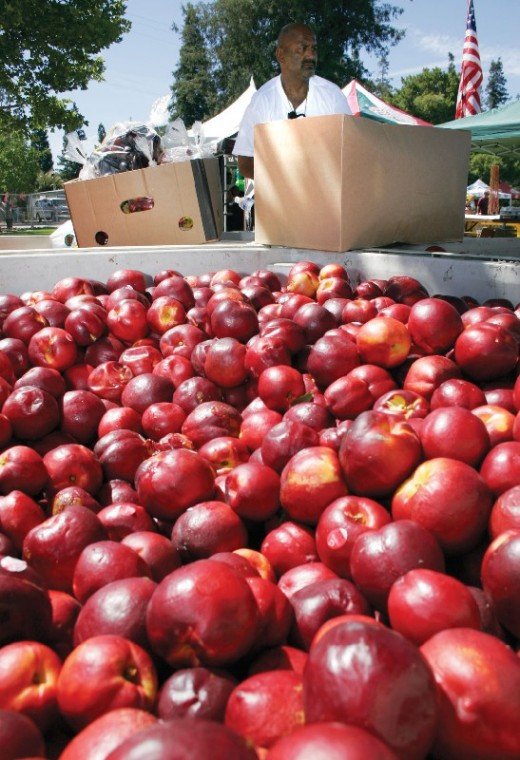Immigrant farmworkers work long, hard days toiling in fields and
orchards. The fruit
– and vegetables – of their labor ends up on dinner plates
around the world, yet seldom are they appreciated for their
contributions.
By Perry Shirley Staff Writer
Gilroy – Immigrant farmworkers work long, hard days toiling in fields and orchards. The fruit – and vegetables – of their labor ends up on dinner plates around the world, yet seldom are they appreciated for their contributions.
The third annual Celebracion Del Campo, held Sunday at Christmas Hill Park, was a six-hour festival for these very workers.
An estimated 3,000 attended and enjoyed the food, refreshments, a slew of entertainment, free produce and scores of informational booths explaining health programs, educational opportunities and job offers they may not have heard about.
“It’s about giving back to great people who put in tremendous physical effort that not many people like to do,” said radio DJ Edgar “Choboi” Sotelo of FM 100.7 La Kalle station. “It’s to say ‘thank you for your work in agriculture, now let’s move forward.’ ”
Eager hands lined up Sunday to grab heaps of free fruits and vegetables bagged up by volunteers from the Second Harvest Food Bank, donated by Santa Clara County farmers.
More than 2,000 pounds each of squash, potatoes and onions were given away, said volunteer Vicki Martin, and upward of 1,500 each of corn, plums, nectarines and tomatoes made it into the hand of farmworkers.
Volunteer David Cameron, 36, said there was “a very good chance” that they were handing out produce to the very same people who picked them out of the ground – but may not be able to afford to buy them in stores.
“They work hard but don’t have much to show for it,” Cameron said.
The day was tailor-made to give something back to the workers. While the health, education and job services focused on quality of life, the nonstop entertainment gave people something to cheer about.
With elaborate ostrich-feather headgears, colorful garbs and accessories, performers on the main stage looked the part of traditional Aztec dancers.
“Our culture has long had a special relationship with the earth, la madre tierra, and staying healthy so we are here to share this energy with you,” explained one dancer before pushing into an illustrative number about wind and seeds.
To the beat of the male drummers behind them the female dancers tapped, toed and pounded the ground with their decorated feet, reflecting the act of seeding and working the soil in a driving, well-choreographed dance.
“Let’s create a message of support for our farmworkers,” the announcer continued, “because they are the providers of many things that we eat.”
While the Latino hip-hop and reggaeton acts entertained, the Aztec dancers, much like the gray-suited Mariachi band that wandered through the crowds, mirrored South American culture.
Debra DeGroot, 52, a Gilroy resident whose maiden name is Cruz, said she particularly liked the dancers because they celebrated her family’s indigenous roots.
“It is part of our hearts. It makes us very proud to be of this culture,” DeGroot said. “We’re Americans, but we’re also Aztecos.”
Many companies and organizations were there to offer services to immigrants – documented or not – that farm workers may not be aware of.
More often than not, however, it was children, not their parents approaching tables. Immigrant farm workers can be hesitant and afraid to look into services because they are not sure if someone will speak Spanish to them, said Monique Melchor, a program manager for Work2future, the job training agency that organized the event.
Some groups were very specific about what portion of the farm workers they target.
Lorena Tariba of the Migrant Education Program said children of migrant workers – laborers who move across the state or across statelines at the whim of crops and seasons – spend a limited amount of time in any one school district.
This can lead to unhealthy living habits, she said, because the constant change makes it hard for them to develop healthy routines such as walks down to neighborhood parks to meet with friends or regular checkups with the same doctors.
There are an estimated 1,200 migrant children in the Gilroy Unified School District, but the number fluctuates depending on the season, Tariba said. The often-interrupted school year can be particularly hard on them. To combat this, one of the program’s many services is to offer at-home tutoring in the company of both child and parent.
Because health care is critical for any family but often completely out of financial reach for farmworkers, preventative measures were the focus of many booths.
Cookbooks in Spanish that offer healthy Mexican recipes made with fresh, mostly vegetarian ingredients were handed out by Latino Champions For Change campaign. A 2005 study found that more than 50 percent of the adults in California are overweight or obese, according to Pamela Harris, the campaign’s coordinator.
Pilar Fregoso, a 42-year-old who cleans homes in Morgan Hill while her husband works fields, got the bad news that her blood sugar level hit 362, a sure sign of developing diabetes. Heavyset with a soda in hand, Fregoso sheepishly said she knew she would have change some things in her life.
Mexican immigrants are particularly at risk of the disease because in their food culture it’s common to eat “six or seven tortillas,” which have similar nutritional equivalence of an equal amount of bread slices, constitutes far too many calories, said Sister Rachela, an nurse with Saint Louise Regional Hospital.
The good news is that the disease is treatable and can be dealt with if caught early, according to the nurse who gave free diabetes blood checks at her booth.
Because farm workers seldom have regular doctor visits and the symptoms of the disease are hard to detect, the hospital has just created a new outreach program. Specially-trained Spanish-speaking Latino workers called “Promotores” will go into fields and single out potential diabetics by eyeballing body sizes and talk to them about getting checkups or treatment.














